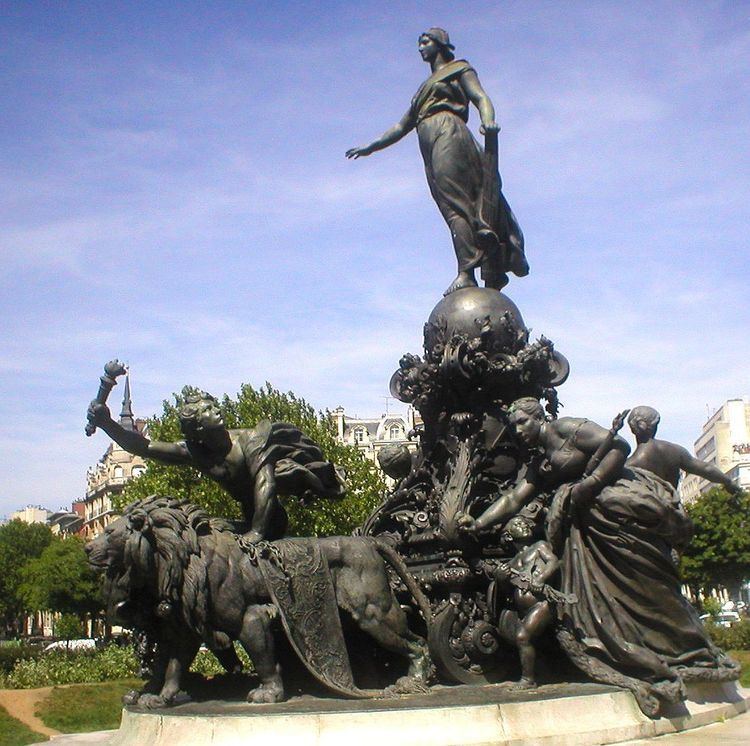Length 252 m (827 ft) Inaugurated 2 July 1880 | Denomination 2 July 1880 | |
 | ||
Width 252 m (827 ft) (circular with diameter = 252 m) Quarter Sainte-Marguerite . Picpus From Rue du Faubourg Saint-Antoine Completion Already present on the Delagrive plan in 1728 Hours Open today · Open 24 hoursTuesdayOpen 24 hoursWednesdayOpen 24 hoursThursdayOpen 24 hoursFridayOpen 24 hoursSaturdayOpen 24 hoursSundayOpen 24 hoursMondayOpen 24 hoursSuggest an edit Similar Nation, Place de la République, Place de la Bastille, Porte de Vincennes, Place d'Italie | ||
Lesser known monuments of paris place de la nation
The place de la Nation (formerly place du Trône, subsequently place du Trône-Renversé) is a circle on the eastern side of Paris, between Place de la Bastille and the Bois de Vincennes, along the border of the 11th and 12th arrondissements.
Contents
- Lesser known monuments of paris place de la nation
- Place de la nation explore france
- Ancien Regime
- French Revolution
- 19th century
- 20th century
- References
Widely known for having the most active guillotines during the French Revolution, the square was renamed the Place de la Nation on 14 July 1789, Bastille Day.
Featuring a large bronze sculpture, the 'Triomphe de la République', the square is encircled by shops and a flower garden — and is served by the Paris Metro station Nation.
Place de la nation explore france
Ancien Regime
To this day, Paris bears traces of the mur des Fermiers généraux, a wall built between 1784 and 1791, one of the several city walls built between the early Middle Ages to the mid 19th century well beyond the buildings of Paris in a campaign to encircle houses, gardens and monasteries for the purpose of controlling the flow of goods and to enable their taxation by the Farmers General.
The wall's construction left a vast grassy space of vines and market gardens as far as the medieval city wall and the walls of the gardens of the old village of Picpus, filled with large convents, schools and retreats. A throne was erected in this space on 26 July 1660 for the solemn arrival of Louis XIV and Maria Theresa of Spain following their wedding in Saint-Jean-de-Luz. This gave the square its original name of "Square of the Throne", Place du Trône.
Originally, the square accommodated two pavilions and two columns of the barrière du Trône designed by Claude Nicolas Ledoux and built for the barrier of octroi (Mur des Fermiers généraux) which surrounded the entrance to the cours de Vincennes. The columns were surmounted by statues of Kings Philip II and Louis IX.
French Revolution
During the Revolution, the square was renamed Place du Trône-Renversé - Square of the Toppled Throne - on 10 August 1792. A guillotine was set up in the southern half of the square, near the Pavilion of Law built by Ledoux. Those guillotined there were buried in the at Cimetière de Picpus and include:
19th century
The central monument, "The Triumph of the Republic", is a bronze sculpture created by Aimé-Jules Dalou. It was erected to mark the centenary of the French Revolution, at first in plaster in 1889 and then in bronze in 1899. It represents a personification of the Republic, and looks towards the place de la Bastille. The figure stands on a globe in a chariot pulled by lions and surrounded by various symbolic figures. When the sculptures were erected, it was surrounded by a large pond. Additional sculptures of alligators, symbols for the threats of democracy, were removed during the nazi occupation of Paris and melted down.
20th century
On 22 June 1963, the magazine Salut les copains organised a concert at Place de la Nation, featuring singers such as Johnny Hallyday, Richard Anthony, Eddy Mitchell and Frank Alamo. It attracted over 150,000 young people. The headline of the following day's issue of the journal Paris-Presse read, "Salut les voyous !". The photographer Jean-Marie Périer, who was a friend to many of the performers, photographed the concert. The Place de la Nation continued to be the location of the foire du Trône before the pelouse de Reuilly.
